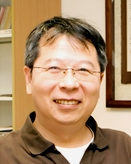P417
886-2-2789-6711
wbsu [at] phys.sinica.edu.tw

P417
886-2-2789-6711
wbsu [at] phys.sinica.edu.tw
周泳恩 / 886-2-2789-8364
michelle0831[at]gate.sinica.edu.tw
| (1) | 國內學術研究獎項 | 2013-01 | 中華民國物理學刊優良論文甲等獎 | |
| (2) | 國內學術研究獎項 | 2011-06 | 中研院年輕學者研究著作獎 |
| 主要相關著作: |
| Wei-Bin Su*, Chun-Liang Lin, Wen-Yuan Chan, Shin-Ming Lu, and Chia-Seng Chang, 2016, “Field enhancement factors and self-focus functions manifesting in field emission resonances in scanning tunneling microscopy”, NANOTECHNOLOGY, 27, 175705. (SCIE) (IF: 3.874; SCI ranking: 41.4%,55.1%,27.5%) |
| 主要相關著作: |
| Shao-Wei Weng, Wei-Hsiang Lin, Wei-Bin Su*, En-Te Hwu, Peilin Chen, Tsong-Ru Tsai and Chia-Seng Chang, 2014, “Estimating Young’s modulus of graphene with Raman scattering enhanced by micrometer tip”, NANOTECHNOLOGY, 25, 255703. (SCIE) (IF: 3.874; SCI ranking: 41.4%,55.1%,27.5%) |
| 主要相關著作: |
| W. Y. Chan, H. S. Huang, W. B. Su*, W. H. Lin, H.-T. Jeng, M. K. Wu, and C. S. Chang , 2012, “Field-Induced Expansion Deformation in Pb Islands on Cu(111): Evidence from Energy Shift of Empty Quantum-Well States”, PHYSICAL REVIEW LETTERS, 108, 146102. (SCIE) (IF: 9.161; SCI ranking: 8.1%) |
| 主要相關著作: |
| M. C. Yang, C. L. Lin, W. B. Su*, S. P. Lin, S. M. Lu, H. Y. Lin, C. S. Chang, W. K. Hsu, Tien T. Tsong, 2009, “Phase Contribution of Image Potential on Empty Quantum Well States in Pb Islands on the Cu(111) Surface”, Physical Review Letters, volume 102, p.196102-1-p.196102-4. (SCIE) (IF: 9.161; SCI ranking: 8.1%) |
| 主要相關著作: |
| C. L. Lin, S. M. Lu, W. B. Su*, H. T. Shih, B. F. Wu, Y. D. Yao, C. S.Chang, Tien T. Tsong, 2007, “Manifestation of Work Function Difference in High Order Gundlach Oscillation”, Physical Review Letters, volume 99, p.216103-1-p.216103-4. (SCIE) (IF: 9.161; SCI ranking: 8.1%) |